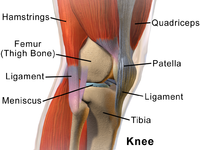
Photo from wikipedia
BACKGROUND Immobilization in external rotation after a first-time shoulder dislocation was introduced to reduce the risk of recurrence compared to immobilization in internal rotation, but its efficacy remains controversial. The… Click to show full abstract
BACKGROUND Immobilization in external rotation after a first-time shoulder dislocation was introduced to reduce the risk of recurrence compared to immobilization in internal rotation, but its efficacy remains controversial. The purpose of this study was to determine the long-term effect of immobilization in external rotation after a first-time shoulder dislocation. METHODS Between October 2000 and March 2004, 198 patients with a first-time anterior dislocation of the shoulder (average age 28) were randomly assigned to immobilization in external rotation (ER group = 104 shoulders) or internal rotation (IR group = 94 shoulders) for 3 weeks. At an average 2-year follow-up, 159 patients (80.3%) were available for evaluation. In the current study, these 159 patients were further followed up and interviewed by telephone. The following items were evaluated: recurrent instability, apprehensive feeling, surgical intervention, limitation in the range of motion, return to sports, and the single assessment numeric evaluation (SANE) score. RESULTS The average follow-up period was 18.2 years (range, 16 - 20 years). Fifty-six patients were available for follow-up with the follow-up rate of 35%. The recurrent patients were 6/27 (22%) in the ER group and 6/29 (21%) in the IR group (p = 0.889). The surgically stabilized patients were 3/27 (11%) in the ER group and 10/29 (34%) in the IR group (p = 0.038). In total, the recurrence rate was 9/27 (33%) in the ER group and 16/29 (55%) in the IR group (p = 0.100). Adding the surgical cases and those with the SANE score ≤ 70% as failure cases, the failure rate was significantly lower in the ER group (26%) than in the IR group (52%) (p = 0.048). Among those who survived without surgical intervention, there were no significant differences in apprehensive feeling, return to sports, limited range of motion, and the SANE score between the groups. CONCLUSIONS Immobilization in external rotation reduced the risk of surgical intervention compared to internal rotation in the long-term.
Journal Title: Journal of shoulder and elbow surgery
Year Published: 2021
Link to full text (if available)
Share on Social Media: Sign Up to like & get
recommendations!